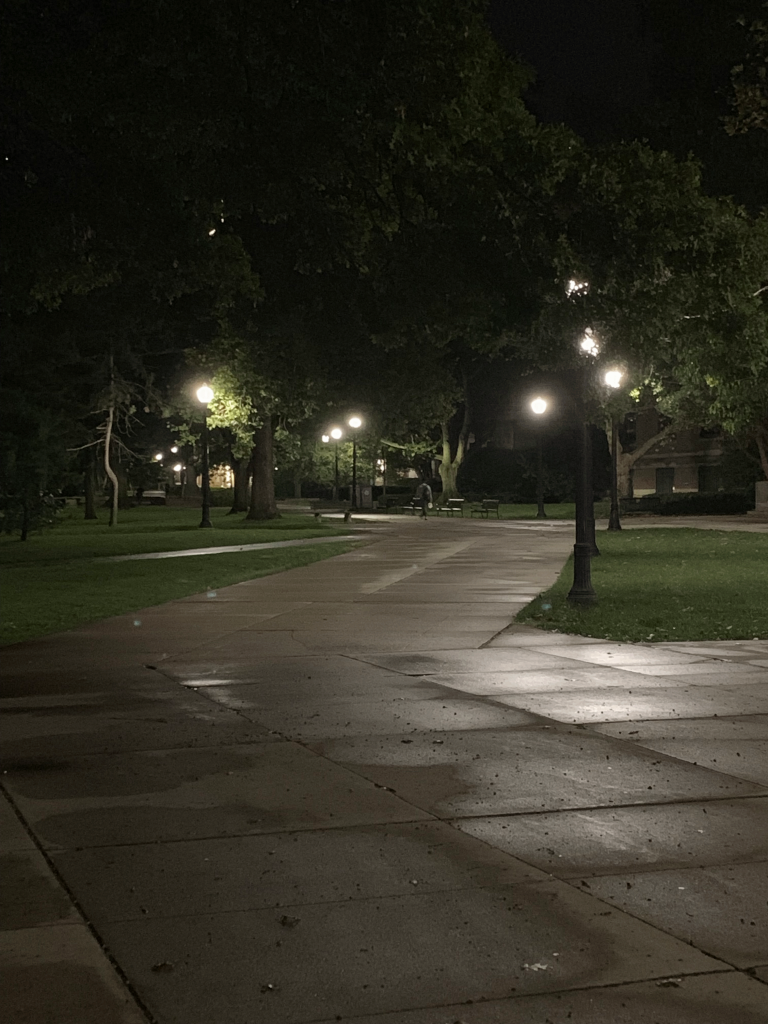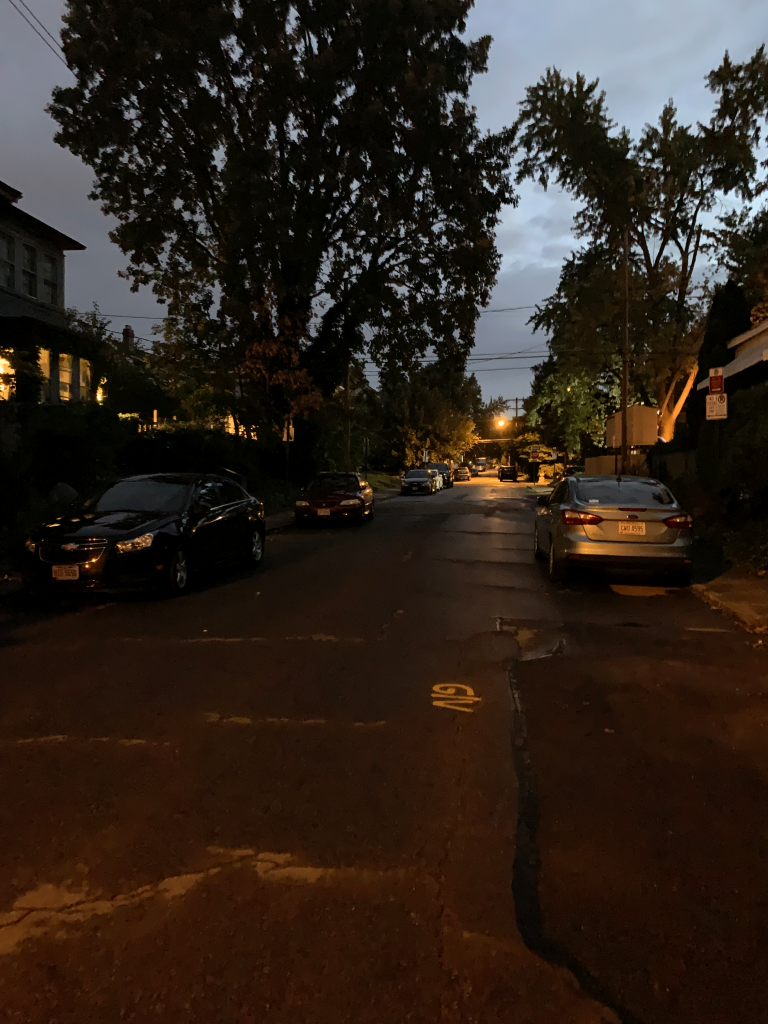by Dexter Kowalski, 2019
None of us like to be afraid. Sure, the occasional horror movie or roller coaster are good to get your fix of adrenaline, but you know that in the end you are going to be ok. That isn’t always the case when you are simply walking through your neighborhood, especially at night. No matter where you are going, you should be able to feel safe and secure in your travels. One of the main contributors to the uneasy feeling you get when walking around on streets at night is the lack of adequate lighting. The only streetlights create deep shadows that can make a perfectly safe side of the street seem like a back alley in a rough part of town.

The lighting on campus itself is quite good. There is an ample number of lamps, placed quite closer together so that the majority of the sidewalks are in the light. The blue emergency poles are a reminder that help is right around the corner on campus. That being said, most of the main roads and foot paths on the academic core do not share the same lighting issues that the surrounding areas have. Specifically, I have identified two areas of interest, the first of which being the area to the North-East of the academic core, and the second being the West Carmack.

As you make your way North into the University Campus area, it seems as though the lights were just turned off. There is noticeable decrease in street lighting once you head into the city’s jurisdiction. Most of this neighborhood is home to students that go to The Ohio State University, and commute to and from campus everyday. I took a survey of individuals that live in the area and found that 45.7% only walked one to two nights per week and 39.1% walked 3-4 nights per week. Although this seems low, it is the most used form of transportation, followed by the bike where 78.3% of people responded that they never ride their bike during the night. This has a negative correlation with how safe people felt. When asked how safe each mode of transportation felt, 45.6% of participants responded with a one or two, one being feeling the least safe; where with the bike 69.9% of the participants responded with a three, four or five. It started to become clear to me that the issue was the feeling of safety when walking, and for medium range commutes. Out of all of my participants, the majority of nightly commutes took an average of 11-15 minutes, which can be quite a long time to walk alone in the dark.
I sat down with Courtney Falato (the Smart Cities Relationship Director) and Beth Snoke (Director of Transportation and Traffic management at Ohio State) to discuss the issue and see what the University and the city has been doing to try to improve the near campus commute safety. Something I found interesting was they there is already a shuttle service available to students that live close to campus, and the first five dollars of the ride is subsidized. This same service is looking to be rolled out soon using autonomous vehicles. What I found more interesting is that there is a geofenced area in the off-campus neighborhoods that the University is sponsoring this service for, which means that there is room for the University to help make change in the surrounding area around campus to improve night commuting safety.
What I also find interesting is that people still feel unsafe even in relatively crime free areas. Although there is less violent crime that happens on the north side of campus, the feeling of being unsafe in the environment. There doesn’t seem to be a correlation to how safe the area is and how safe it is perceived to be. This means that making someone feel safer won’t necessarily decrease the chance of crime that could occur. But what this does mean is that by increasing the feeling of safety, there would be more people on the streets later at night, which means there are more witnesses to any crime that might take place, therefore decreasing the chance of crime. As the saying goes, there are safety in numbers.
The second point of interest in the West Campus Carmack lot. This is a massive parking lot located approximately miles from the academic core. A large portion of the long distance commuters have to park at Carmack five, and then take the bus to main campus. If these individuals have to stay later, they have to wait outside for the bus and then get dropped off, far past sunset, at one of two available bus stops. This lot is becoming more crowded than it used to since the medical campus construction pushed all of the parking for Wexner Medical Center employees to the West Campus Carmack. With increased traffic, there is a higher chance that a pedestrian trying to make it to one of the scarce bus stops could be hit by a tired driver early in the morning or late at night.


The lighting fixtures that are in the lot are dim, and have a quite a lot of fall off as the light gets farther from the lamp. This can create confusing shadows and reflections off of the asphalt, especially when the surface is wet and make it hard to see people walking across the lot. Increasing the general luminance of the lot would solve some of these basic problems.
Another issue with the safety of Carmack five, is that in the next decade or so the entire area will be different, and the lot will no longer be there. According to Beth Snoke, “there’s out but there is new in” in regard to the parking lot redistribution. New drawings for these plans have already been laid out as part of Ohio States future development plan, and it will be interesting to see what the proposed plans are. I am hoping to follow up with Snoke and Falato soon to get more in-depth data and information that they can provide that will help more fully understand the commuters on campus.
There is a very human need and want to feel safe in your surroundings. Unfortunately, some of the most populated areas on and around campus are lacking the comfort that a community should provide. The dim and sometimes non-existent lighting on residential streets make room for criminals to hide away and strike late at night. If commuters can make it to the parking lot safe to park their car, does it really matter if they can’t get to campus without fearing for their safety? Getting to and form campus should be a pleasant thing to do and not a burden, and I think that this is a problem that should be taken more seriously and would increase the overall well being of the university.



